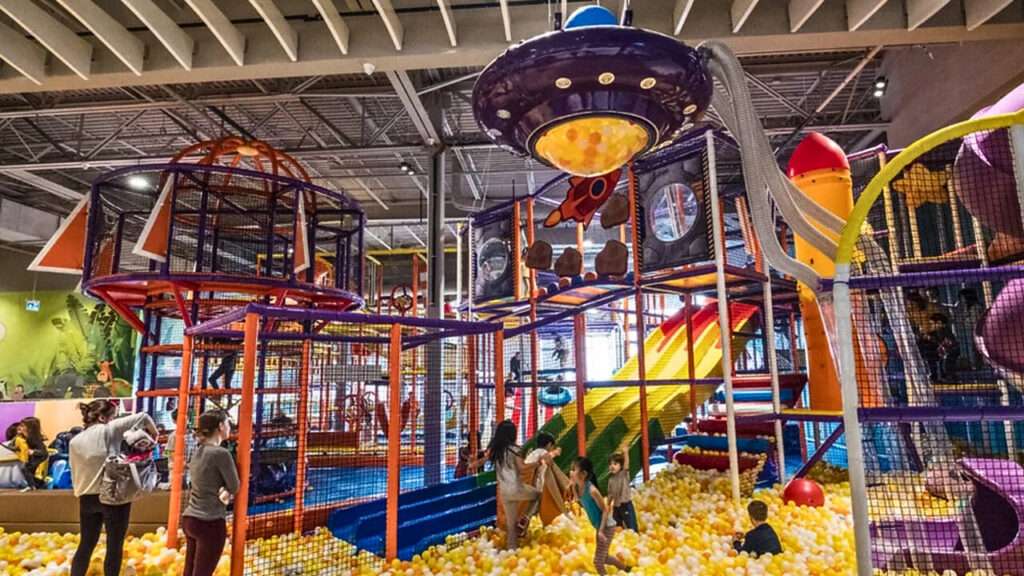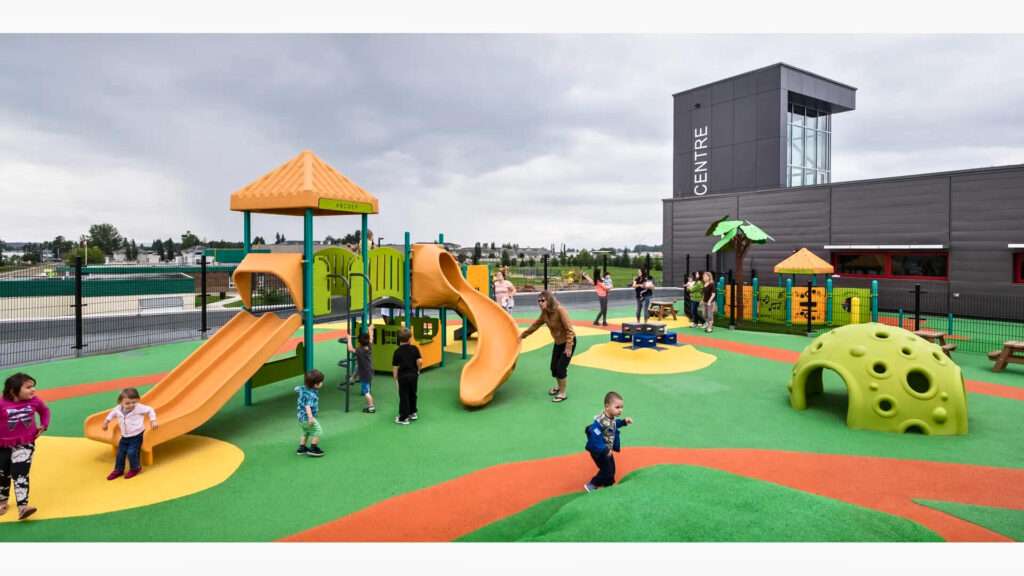Childrens Play Areas play a very important role in our children’s growth. The act of playing is not only an enjoyable activity for children. Rather, it is an essential component of their growth and development. Young children acquire knowledge, discover new things, improve their social skills, and grow physically via play. In order for this essential development to take place, children’s play spaces. That has been thoughtfully created offer a setting that is both secure and exciting.
This article goes into the realm of children’s play areas, examining the numerous sorts of play areas. The advantages that they offer to children of all ages. And the factors that should be taken into account when designing the ideal play space.

Childrens Play Areas Types:
In the realm of children’s playplaces, there is a wide variety of entertaining options. An examination of some of the more prevalent categories is as follows:
- Traditional Playgrounds: Swings, slides, seesaws, and climbing structures are some of the typical playground equipment. That may be found in these more known areas. Traditional playgrounds are characterized by their simplicity and effectiveness since they foster physical exercise, coordination, and imaginative play.
- Themed Playgrounds: An additional degree of excitement may be added by including a theme. Such as a pirate ship, jungle, or castle. Imagination may be sparked in children by themed playgrounds. Which also inspires youngsters to engage in pretend play and tell stories.
- Nature Playgrounds: Logs, boulders, sand, and artificial water features are some of the natural components. That is incorporated into these areas. Children are encouraged to explore, learn, and form relationships with the natural world via the use of nature play spaces.
- Indoor Play Areas: Indoor play facilities provide a range of climbing structures, ball pits, and soft play equipment. And interactive activities, which are especially handy during times of rainy weather. These places are wonderful for engaging in physical exercise as well as interacting with other people.
- Sensory Play Areas: A variety of elements, such as water features, tactile surfaces, textured walls, and sound installations. May be included in these locations with the intention of stimulating the senses. It is essential for the development of young children to have sensory play spaces. That are designed to accommodate children who have a variety of learning styles.
- Water Play Areas: The use of splash pads, water fountains, and tiny pools provides youngsters with a revitalizing and enjoyable approach to cool off and stay entertained. Activities such as problem-solving, sensory exploration, and physical exercise are all encouraged in water play spaces.
Childrens Play Areas Benefits:
The benefits of well-designed children’s play areas are undeniable. Here are some of the key advantages of Childrens Play Areas:
- Physical Development: Parks and playgrounds encourage physical exercise, which is critical for the development and growth of children in a healthy manner. Developing gross motor abilities, coordination, and physical strength may be accomplished through activities like as climbing, swinging, running, and jumping.
- Cognitive Development: Cognitive growth is facilitated by play, which in turn encourages creative problem-solving, critical thinking, and critical thinking. Through the use of their imaginations, children learn how to navigate equipment, construct constructions, and more.
- Social Development: Playgrounds offer a natural environment in which people may engage with one another. The development of friendships, sharing, taking turns, and good communication are all skills that children acquire.

- Emotional Development: Children may learn to communicate their feelings, learn to cope with stress, and increase their confidence via play. They acquire the skills necessary to triumph over obstacles, to take chances, and to deal with disappointments.
- Sensory Development: Touch, sight, hearing, smell, and taste are just some of the senses that may be stimulated by play environments that are created to be designed to excite. Exploration of the senses is essential for the development of the brain in its early stages.
- Mental Health: Participating in play can help improve mental health by lowering levels of stress, anxiety, and sadness. Having a sense of success, engaging in social connection, and engaging in physical activity are all encouraged!
- Lifelong Benefits: The knowledge and abilities that are gained via play have an effect that is long-lasting. Children who develop their social skills, communication skills, self-confidence, and creative ability during childhood are more likely to achieve success in their academic and professional lives later in life.
Creating the Perfect Childrens Play Areas
Designing a play environment at home, at a park, or in a daycare center requires numerous considerations:
- Age-appropriateness: The children who will be utilizing the area should have their developmental requirements and skills taken into consideration while selecting the equipment and activities that will be used.
- Safety: Safety is of the utmost importance. Make sure that the equipment is well-maintained, that it complies with safety regulations, and that it has the right surfacing in order to reduce the likelihood of accidents and falls.
- Accessibility: Consider children with disabilities and include features like ramps, wheelchair-accessible equipment, and tactile pathways for visually impaired children.
- Variety: Offer a mix of equipment and activities to cater to different interests and physical abilities. Include elements that encourage physical activity, imaginative play, and social interaction.
- Supervision: Adult supervision is crucial while children are playing. Provide adequate seating and designated areas for adults to observe without hindering play.
- Natural Elements: Incorporate natural elements like trees, grass, and hills whenever possible. Nature play allows for open-ended play and exploration and fosters a connection with the environment.
- Sustainability: For play equipment, use materials that are long-lasting and good for the environment, and think about using recycled or repurposed components. This teaches students about the need to be environmentally responsible and encourages sustainability.

Beyond the Childerns Play Areas: Additional Considerations for Children’s Play
Playgrounds are great, but there are many more ways to play. Additional factors for a well-rounded play environment:
- Open-Ended Play: Go beyond activities that are scheduled and instead encourage play that is open-ended. When children are given this opportunity, they are able to utilize their imaginations, experiment with a variety of materials, and create their own games. In order to stimulate creative thinking, you should include loose pieces like as blocks, crates, twigs, and scraps of cloth.
- Arts and Crafts: Children get the opportunity to work on their problem-solving abilities, improve their fine motor skills, and express themselves artistically via the activities of arts and crafts. Provide children with a wide range of materials to choose from, including crayons, paints, markers, playdough, and construction paper.
- Storytelling and Dramatic Play: Create a space for storytelling and drama. A simple corner may be made using puppets, costumes, and accessories. Encourage them to create tales, act them out, and try out different parts.
- Quiet Play Areas: It is important to provide a specific location for peaceful play and relaxation. Pillows, novels, and plush animals may be used to create a warm and inviting space in this area.
- Music and Movement: The growth of youngsters is greatly aided by the presence of music and movement. You should incorporate activities like as singing, dancing, and moving into the play area. Musical instruments should also be used.
- Community Involvement: Take into consideration the possibility of introducing elements that promote interaction with the community. A communal garden, a place for outdoor concerts, or seats that invite parents and grandparents to relax while their children play are all examples of what may be the case here.
Childrens Play Areas Safety First: Essential Considerations for Safe Play
Any kind of play must prioritize kid safety. Important safety tips:
- Regular Maintenance: Wear and tear on play equipment should be checked on a regular basis. Make certain that all of the bolts are in place, that the surfaces are smooth, and that there are no sharp edges.
- Surfacing: In order to reduce the severity of the impact that falls have on equipment, it is important to use appropriate surface materials such as rubber mulch, sand, or wood chips.
- Supervision: Children should always be supervised when they are playing, particularly when they are using unfamiliar equipment or when they are in strange locations.
- Sun Protection: When children are playing outside, it is important to supply them with shade and advise them to wear helmets and sunscreen.
- Age-Appropriate Activities: Ensure that the child’s age and ability are taken into consideration while selecting activities and equipment.
- Clear Boundaries: It is important to establish distinct boundaries inside the play area in order to prevent children from departing or accessing areas that are not safe.
Children Play Areas: The Role of Adults in Fostering Play
Even while playgrounds and play places that are thoughtfully built are necessary, the role that adults play in encouraging children to play is just as crucial. Adults can make a contribution to the playful experiences of children in the following ways:
- Be Present: When children are playing, it is important to put aside any distractions and actively connect with them. Engage in activities like as reading tales, playing games, and constructing imagined worlds together.
- Follow the Child’s Lead: During play, children should be allowed to take the initiative. Make sure to take note of their interests and provide them direction and assistance without pushing your own thoughts on them.
- Ask Open-Ended Questions: Through the use of open-ended questions such as “What are you building?” or “What happens next in your story?”, you may encourage curiosity and investigation.
- Celebrate Mistakes: Playtime is a time for learning and experimenting with new things. It is important to provide a secure setting in which errors are seen as chances for learning and development.
- Be a Role Model: Through your own fun behavior, demonstrate to young children how to use their imaginations. Engage in funny games, tell jokes, and set the stage for an environment that is packed with joy.
Through the creation of play situations that are stimulating, the promotion of open-ended exploration, and active participation in play, adults have the ability to cultivate a love of learning in children and provide a solid basis for their advancement and development.

Children’s Play Areas Conclusion:
The purpose of children’s play spaces is not limited to providing entertainment; rather, they are crucial for promoting healthy growth and overall well-being. We have the ability to enable children to learn and grow by providing them with play places that are safe, stimulating, and suitable for their age.
This lengthy essay delves deeper into the significance of children’s play places, going beyond the significance of their physical architecture alone. In it, the significance of open-ended play, the incorporation of a variety of activities, the value of putting safety first, and the critical role that adults play in supporting children’s playful experiences are discussed in depth. We can provide the groundwork for children’s development that is joyful, healthy, and well-rounded if we have an awareness of the myriad of advantages that play offers and if we create play situations that are enriching of their experiences.

